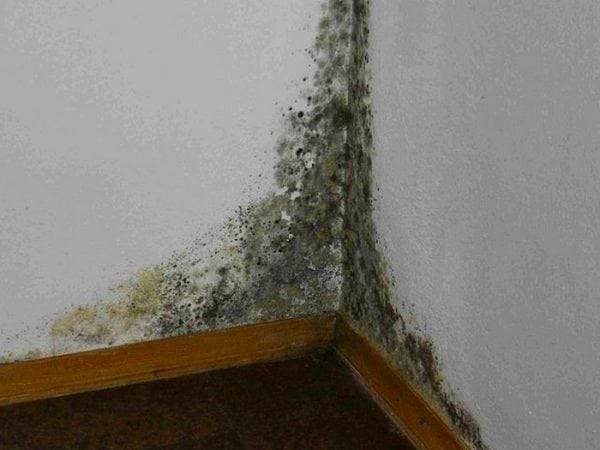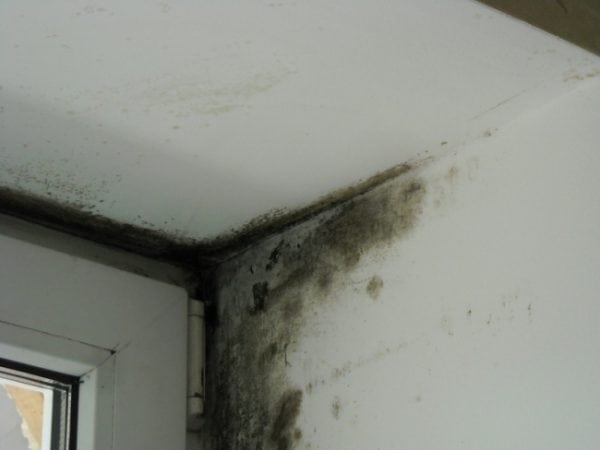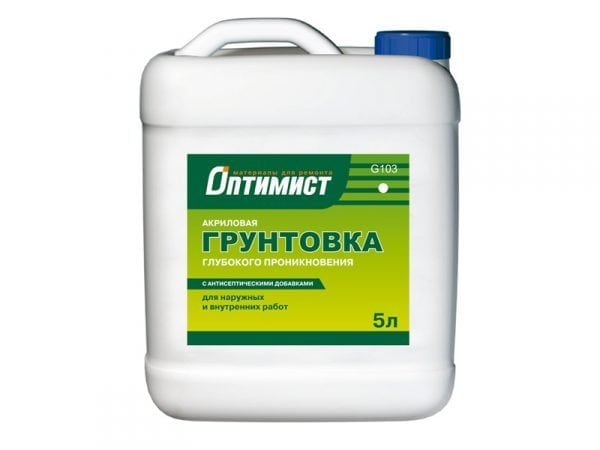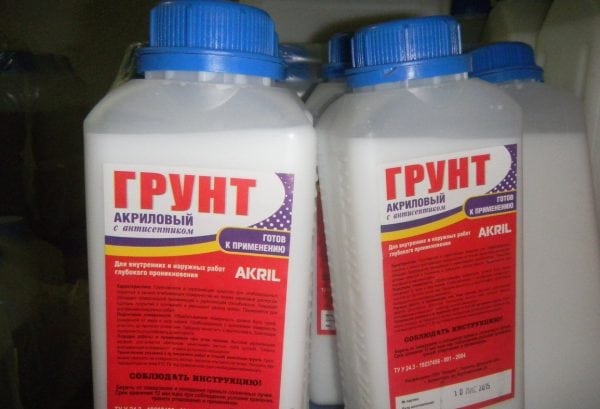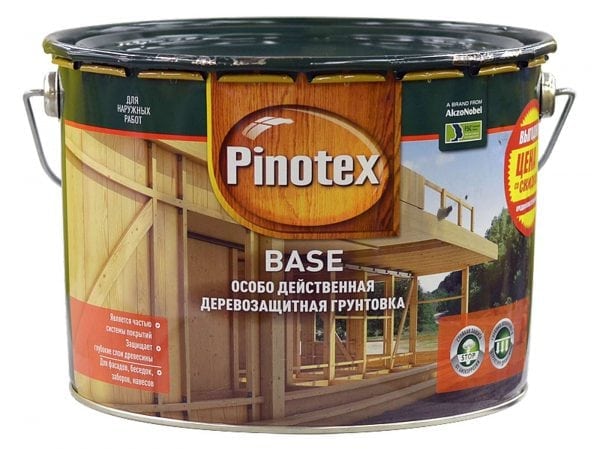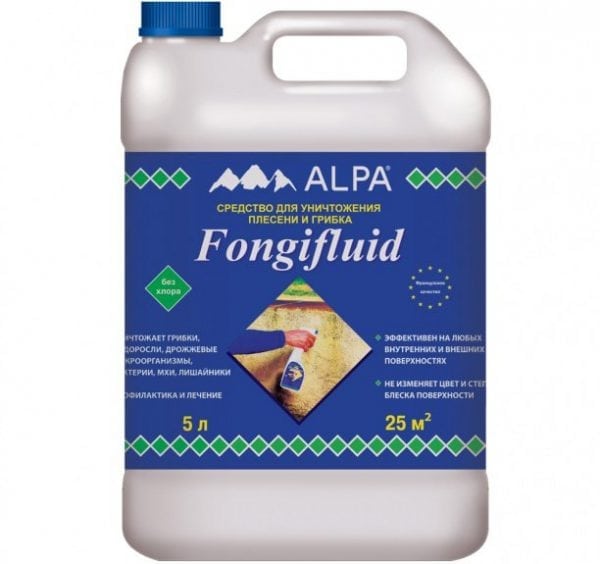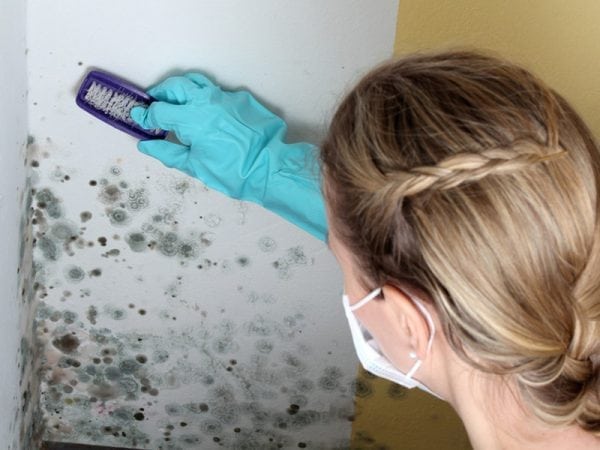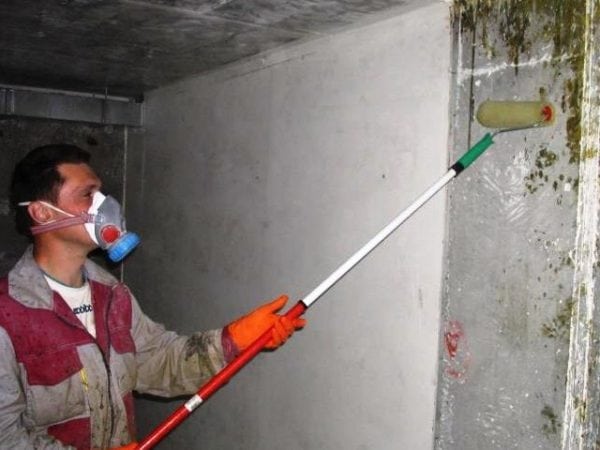The special composition of antifungal primers helps fight mold. Spores of the fungus are able to spread quickly enough, therefore, their appearance must be anticipated and destroyed decisively and promptly.
- What is dangerous fungus and mold
- Reasons for the appearance
- Types of primers as intended
- Types of primers by composition
- Primers for prevention
- Antifungal Wood Products
- Mold control emulsions
- Alternative methods against mold
- Surface preparation
- Work order
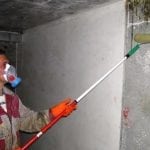
What is dangerous fungus and mold
Living in infected rooms often causes a weakening of the general condition of the body. The spores of the fungus are volatile, easily penetrate by air into the respiratory organs of a person, causing allergic reactions. In addition, microorganisms release toxins throughout their life.
Their excessive accumulation in the room can provoke the development of such diseases:
- asthma;
- bronchitis;
- diathesis;
- migraine;
- mycotoxicosis;
- otitis;
- rhinitis.
Important! In the most severe cases, a fungal infection can lead to disturbances in the cardiovascular system and damage to internal organs.
In addition to harm to health, mold negatively affects the condition of the premises and can cause the destruction of surfaces. With its long exposure, the plaster becomes loose and easily peels off, and the wooden elements turn into dust.
to contents ↑Reasons for the appearance
Mold can appear in any premises, and it is not easy to recognize it. It is especially difficult to do this in the early stages of occurrence, since spores multiply within the material.
The main causes of the appearance of the fungus:
- Inadequate protection of the foundations of buildings from moisture.
- Weak protection of the walls and foundation of the object from the cold.
- Poor processing of joints between panels.
- The emergency condition of the roof.
- Freezing the attic.
- Poor installation of window blocks.
- Poor ventilation system.
- Irregular ventilation of the room.
- Inability of floors (mainly wood) to withstand penetration of moisture.
In all these cases, mold receives suitable conditions for development. To prevent the antifungal composition, it is necessary to use not only at the stages of rough finishing, but also at the final stage (when applying plaster and putty).
to contents ↑Types of primers as intended
Since mold is capable of hitting surfaces of various materials, it is necessary to process floors and walls of concrete, wood, and brick. The primer is applied to drywall or plaster. Compositions are produced for each type of material.
Based on the purpose, antifungal primers are of the following types:
- Plain. Used to prevent mold.
- Antifungal primer deep penetration. It is used to treat surfaces affected by the fungus.Such impregnation destroys the spores inside the material and is characterized by a long action.
Types of primers by composition
The composition of the anti-mold and fungal agents includes various components, in particular acrylic and antiseptic, water and minerals. Depending on this, these types are distinguished:
- Acrylic A fairly common group, including acrylic resins, which improve the adhesion properties of materials. Acrylic primer does not contain harmful substances and dries quickly enough. It is used for processing rooms with high humidity: bathrooms, kitchens, cellars and pools. This primer is applied to the exterior walls of buildings.
- Mineral It is used for processing concrete and brick surfaces, applied to a layer of plaster and silicate materials. The composition contains gypsum or cement. It contains natural substances, therefore it does not have a negative effect on the human body.
- Alkyd. This primer is suitable for the treatment of wooden surfaces. The composition not only prevents the spread of the fungus, but also prevents the swelling of wood. The use of this primer for the protection of tiled, steel or glass surfaces is allowed. It is possible to use drywall or plaster for processing, but in this case the effect will not be so pronounced.
- Quartz. It is applied under paint and decorative plaster. The composition contains sand, which contributes to a sufficiently high level of adhesion of surfaces (adhesion). The final layer is rough.
Primers for prevention
Such products are designed to prevent the growth of harmful bacteria. The most common are:
- Milkill - processing of bricks and concrete. The composition of the primer makes it easy to penetrate deep into the treated surface. It is allowed to cover materials affected by microorganisms.
- Acryl Grundierung is an acrylic-based deep penetration composition characterized by antibacterial, antifungal and adhesive properties. Suitable for treating concrete or brick walls before applying putty and paint.
- Schimmelstop Dufa is a fungicide supplement. It is used as an additional tool for paints and plasters. It is applied with them to places where mold appeared. Used to prevent the development of fungus.
- Mixonit GR43 - has a wide range, is added to dry building mixes. A deep penetration agent, applied to mineral coatings, characterized by high absorption capacity.
Antifungal Wood Products
Wood is considered the most susceptible to mold. For this reason, it must be treated with insecticides, and more than once. It is recommended to do this every year.
Basic means for protecting wooden surfaces:
- Dufa-Holzlasur - azure for wood. Thin-layer decorative composition for restoring old and saving new materials. It protects wood from the negative effects of atmospheric precipitation, destroys existing mold spores and prevents the appearance of regular formations.
- Altax Boramon C30 - indelible impregnation. Protects material from mold and small insects, eliminates developing microorganisms.
- Pinotex Base - exterior wall treatment. An alkyd-based compound is applied to fences, facades, windows and doors immediately before painting.
Mold control emulsions
These special tools can eliminate fungal foci. The most popular are the following:
- Ceresit CT 99 - differs in long action. Ecologically safe concentrate, suitable for processing both internal and external mineral surfaces (concrete, brick, plaster).
- ABEDIS 06 - used to remove organic plaque. The drug is applied to brick walls, tiled surfaces, plaster, concrete walkways. Used for prevention.
- Dali is a universal antiseptic. It is used for prevention before painting, to remove existing mold. It is applied to concrete, brick, and plaster substrates.
- Fongifluid Alpa - “treatment” and prevention. Destroys existing lesions and prevents re-infection. The product treats wooden and brick surfaces, drywall and ceramic tiles, tiles and cement plaster. The concentrate does not prevent air from penetrating to materials, which positively affects the indoor microclimate.
Alternative methods against mold
The use of improvised means is justified when the mold has not yet spread to the entire surface. Mostly used:
- bleach;
- hydrogen peroxide;
- baking soda;
- vinegar.
Home remedies are not as effective as industrial preparations, but much cheaper.
Surface preparation
Before you start treating materials with an antiseptic, you should make sure that there is no fungus. If mold has already spread along the walls, it must be removed. White or bleach will help, which are applied to the surface with a stiff brush.
Priming can be carried out only after the disinfecting solution is completely dry. Before this, the material needs to be heated with a construction hairdryer. This operation will allow the antifungal agent to penetrate deeper into the surface and prolong its effect.
Important! Only dry and clean material that does not peel should be processed.
After processing, all work tools must be sanitized. Thanks to this procedure, mold cannot spread to other areas.
to contents ↑Work order
The primer can be applied with a roller, spray or brush. Using the first tool, a small area is processed, the second is suitable for surfaces of a large area, and the third is used to penetrate hard-to-reach places.
Processing Steps:
- primer distribution over the surface;
- overlay of the second layer (if necessary and only after drying of the previous one);
- finish finish.
Important! It is recommended that work be carried out at an ambient temperature above zero.
The primer is selected taking into account the type of surface. When processing, for example, walls, a composition is used that is designed exclusively for this purpose.
Antifungal primers are indispensable help in the fight against mold. In order to avoid the appearance of fungal colonies, regular treatment should be carried out using the means described above.

